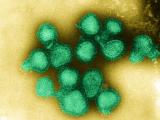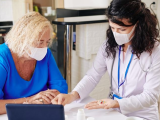(CIDRAP Business Source Osterholm Briefing) – In yesterday's Special Edition, we reported on two potentially alarming developments: a novel swine flu outbreak in California and Texas that had infected seven people, who all recovered; and a much more severe respiratory disease outbreak in Mexico, with 120 reported cases, including 13 deaths.
We said yesterday that it would be very bad news if the mysterious-but-deadly Mexican disease turned out to be the same never-before-seen swine flu virus identified in California and Texas. That would mean that we had (a) a novel flu virus against which people have no natural resistance, (b) spreading across a wide geographical area through human-to-human transmission, and (c) causing serious health effects and even death. Those are the three criteria that are prerequisites for a pandemic.
Here's what we know today:
1. It's settled. Swine flu is killing people in Mexico.
All day today rumors circulated that the US Centers for Disease Control and Prevention (CDC) had established that the bad news had come true: that the deadly Mexican disease was indeed the same novel swine flu virus discovered in the US. At 2:30 pm the CDC held a press briefing and confirmed the rumors. Dr. Richard Besser, acting director of the CDC, was candid that this was alarming news, that the CDC was "more worried" about a possible pandemic than it had been the day before.
The numbers got more alarming today as well. Now the Mexican government says the new strain has killed at least 59 people and infected at least 854. The quantitative news on the US side of the border is better: Only one newly discovered case emerged today, and this person, like the earlier seven, has already recovered.
Nobody knows why the new flu strain is deadly in Mexico and mild (so far) in the US. That will obviously be a topic of intense scrutiny in the days to come. The search for additional cases will also be a top priority. It would be a great relief to learn that the new swine flu is spreading only with difficulty, if that turns out to be true. But we simply don't know yet the effectiveness of human-to-human transmission.
Dr. Besser was clear today that he believed the new virus has probably spread too widely already to contain in its current locations. The World Health Organization (WHO) has hoped that if a new influenza strain were caught quickly enough, its spread might be stopped with an intensive "fire blanket" of antivirals given to people in the area surrounding the outbreak. That's basically the "remote Indonesian village" best-case scenario—not the "two big cities in Mexico plus some other places" reality we face today. If the virus stops spreading, it won't be because human effort contained it; it will spread or stop spreading pretty much on its own, depending on how transmissible it is.
That doesn't mean there is no point in trying to slow the spread—by wearing masks, staying home when you're sick, canceling public events, etc. If it comes to that, so-called "social distancing" strategies should slow the spread of the virus. But "slow" isn't "stop."
Bottom line: There isn't much we can do right now to prevent a pandemic. We're just waiting to see if we've got one.
2. We are now at WHO pandemic phase 4—but the WHO hasn't said so yet.
The WHO has a six-phase index of pandemic risk. Since 1997, when H5N1 infected both birds and humans in Hong Kong, we have been in phase 3, characterized by "no or very limited human-to-human transmission" of a novel and dangerous virus. Phases 4, 5, and 6 are defined, respectively, by "increased," "significant" and "efficient and sustained" human-to-human transmission.
Basically, phase 6 means a pandemic is in progress. Phase 5 probably means a pandemic is inevitable. Phase 4 is the key: It means the pandemic risk is high enough to merit urgent, intensive, international public health interventions, although the pandemic might still not happen.
All day today rumors have circulated about battles within the WHO over whether to ratchet up to phase 4. The specs are certainly met. The evidence of increased human-to-human transmission (compared with the H5N1 "bird flu" record) is clear. But so far the WHO hasn't acted. It's not clear what WHO officials and cooperating experts are considering as they debate this question, and it's certainly not clear what or when the WHO will decide. In fairness, the WHO may simply have been waiting for more solid Mexican data.
But we believe the world is now in pandemic phase 4. If you have a pandemic plan that is keyed to the WHO phases, we urge you to consider yourself in phase 4 as of today.
Once again, that doesn't mean a pandemic is either imminent or inevitable. It means the risk looks high and your precautions should be urgent and more than routine. Now is the time to prepare, emotionally as well as logistically, for the influenza pandemic that may (or may not) be on its way.
We suspect that the WHO is worried that people will (wrongly) think that declaring phase 4 is tantamount to predicting a pandemic within days. Such a declaration would presumably hurt financial markets, influence business decisions, and raise anxiety levels in what is already a difficult economic climate. If all that happened and a pandemic didn't, the WHO's reputation could suffer mightily.
These are serious concerns. But failing to declare phase 4 could also damage the WHO's reputation. And it could arouse even more anxiety and more public and market overreaction. In fact, people are likeliest to panic and act unwisely when they know a situation looks bad and those in authority are pretending otherwise. That's what happened during the SARS outbreak in Beijing. The Chinese government denied the crisis largely in order to allay panic; people became more and more panicky largely because the government was denying the crisis.
We hope the WHO won't make the same mistake. As we write this, there are new rumors that the WHO is about to declare phase 4. We hope it does. Whether it does or not, we urge you to act as if it had.
3. Whether you call it phase 3 or phase 4, now is the time to implement the preliminary parts of your pandemic plan.
Don't get caught up in the phase-3-versus-phase-4 debate. What matters is that a pandemic looks likelier to materialize in the next few days, weeks, or months than it has looked for a long time.
That's not a guarantee. The last time a pandemic looked pretty likely was the early days of the H5N1 spread through Asia—and the pandemic didn't happen. The time before that was the first sighting of H5N1 in Hong Kong in 1997—and it didn't happen then, either. The time before that, ironically, was the US swine flu scare of 1976. President Gerald Ford was alarmed enough about that one to launch a massive vaccination program to protect Americans from the pandemic—and that one didn't happen either.
Flu experts are like hurricane forecasters. The weather map looks bad right now—but it's far from rare for hurricanes to fizzle out or change course. Still, it would be exceedingly foolish not to take serious precautions when hurricane forecasters tell you a big one looks like it might be headed your way.
The current economic crisis makes it difficult to argue for putting resources into pandemic planning when your company is just hanging on the ropes. But that is exactly why you need to plan, because not having a plan all but ensures that your company will go under during a pandemic.
If you've got a pandemic plan, you have thought this through already. You have a list of things to do when a pandemic looks imminent but still iffy—actions that meet three key criteria that they:
- Will help everybody get ready for stronger measures if the news keeps getting worse
- Help your company and your people survive if the pandemic comes
- Will be reversible without too much damage or cost if the threat recedes.
You wrote the plan, hoping you'd never need to implement it—but figuring that sooner or later you might. Now you do implement it, but not the whole plan, at least not yet—just the easier bits.
4. What should you do if you don't have a pandemic plan?
Well, for one thing, get your senior management to resolve right here and now that if the threat recedes this time, you'll do what it takes to have a plan in place—and tested—the next time a serious pandemic possibility looms.
In the meantime, put together a short list of things you can do now, even without a formal plan, to help your company brace for what may be just around the corner. Some things are probably too late to do—like stockpiling enough antivirals for your workforce and developing a protocol for getting them into their hands when they need it.
But there's plenty you can do right now, this weekend, or early next week, that will help. Then if the pandemic threat fizzles (or even if it stabilizes, hanging in abeyance for a few months), you can use the time to work on some longer-term preparedness measures.
For now—for right now—here's our shortlist of short-term suggestions.
- Alert everybody in your organization, from your senior management to your workforce. Make sure what you say is both scary enough and tentative enough: The threat could go away, or it could get very, very bad. Tell them where to get reliable generic information now, and tell them where they'll be able to get reliable company-specific information if the pandemic materializes.
- Do a quick-and-dirty triage plan. In a pandemic, your company simply won't be able to keep doing everything it does now. Business discontinuity, not business continuity, will be the order of the day. Which activities will you jettison fairly quickly? Which ones will you sacrifice greatly to keep operating if you possibly can?
- Assign everybody an emergency duty station. Now that you know what activities you're probably going to discontinue, figure out how you will reassign the personnel who aren't needed for those activities anymore. And tell them their new pandemic assignments now. Research suggests that employees are a lot likelier to come to work in a pandemic to do important emergency jobs than to do their routine jobs.
- Cross-train. Yes, time is tight for this one—but it's too crucial to leave off your shortlist. Figure roughly a third of your workforce and roughly a third of your management isn't going to be coming to work: They'll be sick, dead, taking care of sick family members, mourning dead ones, or too frightened to come to work. Compile a list of everybody's skills: Who can substitute for whom if needed. Figure out who you can't function without—and then have those essential personnel get somebody else ready to step into their shoes if necessary. (You could also consider sequestering them in a safe environment or putting them on prophylactic [preventive] antivirals.)
- Stock up. You can't possibly stock up on everything—especially not on such short notice and given how difficult it is to get loans these days. But make your best guess about which supplies, parts, and equipment you will run out of first when supply lines get stressed by the pandemic (or by fear of the pandemic). Winnow your list, bearing in mind that your budget is limited and some products won't sell in a pandemic anyway. The sooner you do this, the likelier you are to find a seller who still has something to sell. Then go out and buy what you can't manage without. No doubt this action is made harder by current economic realities. But not taking this step can ensure that your company won't survive a pandemic.
- Tell your employees to stock up, too, on food, water, regular medications, batteries, and such. They'll be grateful for the advice. It'll show them you're serious. And if the pandemic materializes, people are a lot likelier to come to work if they feel their family is properly prepared.
- Put together a set of upgraded workplace hygiene practices, such as routinely wiping down doorknobs, elevator buttons, computer keyboards, and the like. We don't know if these practices will really reduce the risk of transmission, as the data supporting them are quite weak. But it can't hurt and will give individuals a sense of empowerment that they are fighting back against the virus. (That'll mean stocking up on the appropriate supplies.) And figure out how much social distancing you can realistically implement by moving people around, replacing actual meetings with virtual meetings, etc.
Do these seven add up to a pandemic plan? No! And if you've got seven better ideas, implement yours instead. The main thing is this: A pandemic may be right around the corner, and you don't have a formal plan for how to cope. So be it. Now do what you can, as quickly as you can. And then if the pandemic hasn't come yet, do some more.
—Peter M. Sandman, PhD, is a risk communication consultant based in Princeton, NJ, and Deputy Editor of CIDRAP Business Source. His writing on risk communication can be found at www.psandman.com; his pandemic communication writing is indexed at www.psandman.com/index-infec.htm.



















